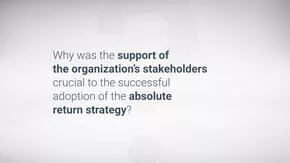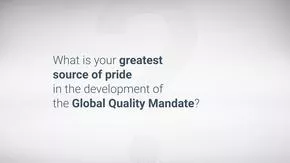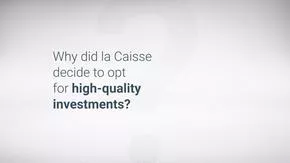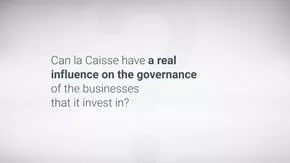Going Against the Flow
La Caisse | What triggered CDPQ’s gradual move from index-based management to absolute-return management?
Jean-Luc Gravel | When I arrived at CDPQ in 2004, most investors were obsessively focused on indexes, and had very short performance horizons. That was the market context at the time.
At CDPQ, there was a desire to do things somewhat differently. To that end, I was inspired by industry thought leaders and their best practices. One source of inspiration was an article I read in an investment industry journal on “investment legends”: Warren Buffet, John Templeton and John Bogle. What struck me in this article was the importance of distancing yourself from indexes which condition investors to engage in short-term thinking.
To generate more stable returns over the long term, it was essential to stop building portfolios based on indexes and start from a blank page. What does that mean in practical terms? It means identifying the sectors in which we truly want to invest and proactively looking for securities with good returns on capital, in sectors that are more stable over a longer-term horizon. I am talking about sectors such as health care, consumer goods and utilities, which are less sensitive to economic fluctuations. This may seem relatively simple, but such a shift represented a significant cultural change. Knowing full well that the path to this new culture would be arduous, we took on the challenge.
La Caisse | In 2011, the economic environment in Europe helped accelerate the shift from index-based management to absolute-return management. How did the idea emerge to create the Global Quality Equity portfolio?
Jean-Luc Gravel | I began leading Equity Markets at CDPQ in the spring of 2009. At that time, we were looking for capital deployment opportunities. The market had just suffered a relatively substantial downturn, and we wanted to make our move, but in an orderly, disciplined way. Replicating an index would have involved buying stocks in European banks, for example, but that would not have been appropriate at that particular time. So, our strategic discussions led to an interesting idea: to buy stock in high-quality European companies, such as Unilever and Nestle. Such European giants were exposed not only to the European market, but also to many other markets around the world. These types of companies had several things in common: strong management, good profitability and excellent stability, but, above all, they were reasonably priced at that time. This is where the idea emerged for the Global Quality Equity portfolio. We planned to allocate four or five billion dollars at the portfolio’s outset, then inject more over time as we developed our teams’ expertise and research capacity.
So, we began to make the most of our “start from scratch” approach, building a portfolio based on our selection criteria and using an analytical toolkit suited to our objectives. For this approach to be effective, we determined our playing field, designed a quantitative filter to restrict the number of companies that our teams would need to evaluate, and made an initial selection of securities. Our teams then conducted detailed fundamental analysis on a limited number of companies. We also created an investment committee, responsible for approving every security added to the portfolio, which ended up approving about 50 securities. By limiting the number of companies in the portfolio, we gave ourselves some time to get our bearings with this new approach.
La Caisse | This focus on quality securities is particularly well suited to CDPQ’s investor profile. However, it severely limits CDPQ’s ability to profit from bull market conditions or from more volatile securities. Does that not represent a disadvantage for CDPQ?
Jean-Luc Gravel | The market often tends to overpay for companies experiencing rapid growth. The reason is simple: everyone is looking for a quick return. It’s cool, it’s fun to obtain exceptional short-term returns. You could say that this is a “sexy” approach. When you compare quality companies with these “sexy” stocks, 10% to 12% annualized returns over five years looks a bit boring. Whereas some people see these stocks as boring and unattractive, we see opportunities for good returns. As a long-term investor, we find that the companies in our Global Quality Equity mandate provide the durability and longevity we seek. We even obtain returns that outperform the index over the long term.
La Caisse | Was this paradigm shift difficult to implement in your teams?
Jean-Luc Gravel | The cultural change our teams underwent didn’t happen at the snap of our fingers. We had to develop a strategy, but also the tools needed for absolute-return management and our long-term view. For example, in terms of analysis, our teams now establish a company’s potential based on expected returns over a seven-year period. It’s important to determine whether we can justify an investment based on an acceptable return over a complete investment cycle, rather than on share appreciation over one or two years. To that end, we assess several aspects: growth, dividend potential, share buyback potential, and changes in the multiple. Investors looking for a short-term return treat changes in the multiple as the core of their analysis. Not us: we are concerned with fundamentals, which we use as our indicators of a stock’s expected return.
La Caisse | Is there one ingredient that can explain the portfolio’s good results since 2013?
Jean-Luc Gravel | The recipe has several ingredients, but one is key: discipline. This portfolio has been a success so far because we have exercised discipline within our teams through an extremely rigorous process. Furthermore, we have convinced our people – analysts, research teams and portfolio managers – of the competitive advantages that this cultural change gives CDPQ as a whole. We also made a point of thoroughly explaining our game plan to our clients. Of course, without the strong support of CDPQ’s Executive Committee and Board of Directors, we could not have even begun this transformation.
La Caisse | What is next? Does the Global Quality Equity mandate open the door to any other initiatives?
Jean-Luc Gravel | Since 2017, we have been constructing the Global Value mandate, which is intended to complement the Global Quality mandate. This new mandate will allow us to take advantage of certain investment opportunities when market conditions change. These two mandates will allow us to make the most of both a bull market and a bear market. We began the work with external managers, and we are gradually funding our internal team which currently has responsibility for approximately $2 billion in assets.
About the Global Quality Mandate
- Securities of well-established companies exposed to global growth, traded on the stock exchanges of countries in the MSCI ACWI Index (United States, Canada, Europe, Australasia, the Far East and emerging markets)
- Highly profitable and stable companies that have strong fundamentals over time, and which demonstrate a conservative use of Financial leverage
Advantages
- Risk-adjusted return exceeding that of equities markets over a long-term horizon
- Geographic diversification
- Protection against inflation over the long term
- Investments which are less sensitive to market fluctuations, and provide higher liquidity during periods of market turmoil





